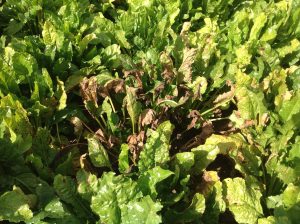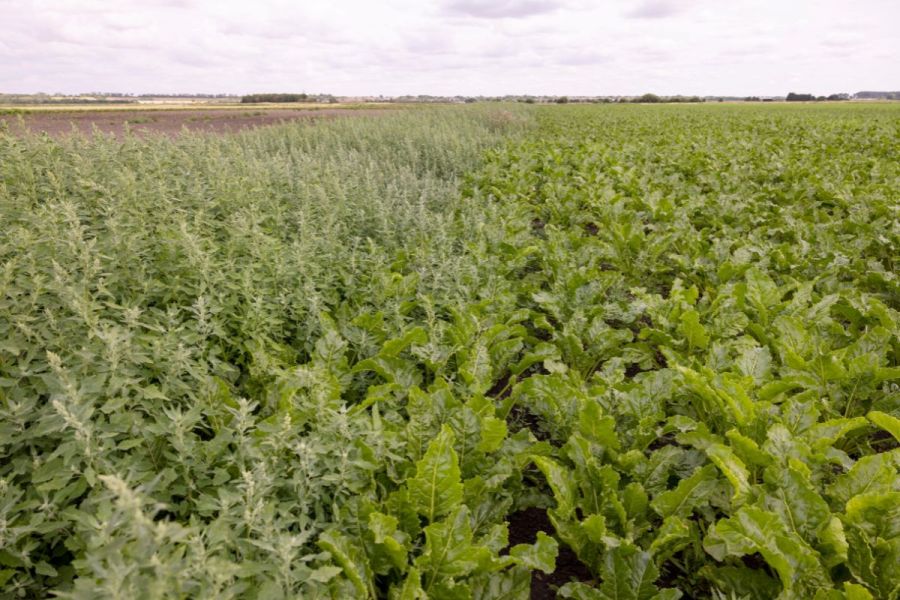A Cambridgeshire farmer is finding ALS-tolerant sugar beet to be useful for a lot more than weed beet control. CPM visits to find out more.
As a new technology, I would put it on a par with the introduction of precision drills. It’s that transformative.
By Rob Jones
Farming across 180ha of peat soils between Holme and Yaxley on the Cambridgeshire Fen, Jonathan Davis is to the point when describing his experience growing ALS-tolerant sugar beet this season. It’s a game changer, he says.
“As a new technology, I would put it on a par with the introduction of precision drills. It’s that transformative.”
Jonathan’s farming situation isn’t unique, but he is in the minority. His immediate challenges comes from farming an average 7.3m (24 feet) below sea-level with a weed burden that’s typical of high organic matter soils (up to 56%).

Jonathan Davis has found the ALS herbicide he can use on the Conviso beet has been very effective at controlling his problem weeds – white campion, Amaranthus and volunteer potatoes.
The first point brings with it an extended period of spring frosts, requiring his sugar beet crops to be drilled later – often a month to six weeks after most growers have finished. The second means a protracted weed control challenge which necessitates repeated herbicide applications.
In the longer term, he’s concerned that a possible pesticide tax and legislation intent on preserving soil carbon could dramatically impact the economic viability of his farm. However, he’s calculated that using the Conviso Smart system has dramatically reduced the herbicide load being applied to his crop, while a move to strip tillage next year should see less carbon released from his peat soils.
“Suggestions, by some, that hoeing can replace herbicides aren’t realistic,” he believes. “Soil testing on this farm revealed there’s 625t/ha of carbon in the top 15cm, so I need to avoid moving the soil wherever possible.”
The 2022-23 season is his first with ALS-tolerant varieties in the ground. And he says his experience has reinvigorated his interest in sugar beet.
“White campion and Amaranthus are our main problem weeds. The difficulty in controlling these had led me to contemplate dropping sugar beet from the rotation, especially since the loss of desmedipham.“
But this year has proved to be be somewhat easier than usual. “The weed control from Conviso One (foramsulfuron+ thiencarbazone-methyl) has been exceptional, including for volunteer potatoes,” he adds.
The sugar beet crop at Willow Hall Farm comprises 34ha of Conviso Smart varieties and 11ha of a conventional variety, which was sown when land became available after the potato area was reduced using seed Jonathan already had in the shed, left over from last season.
“I sowed the classic beet in the field with the lowest weed burden, but it has still needed five post-emergence sprays. The impact of these on crop growth is significant, with some plants still to meet across the rows by late July and it’s still under intense weed pressure,” he comments.
With the difference between crops visible to all, Jonathan has analysed the costs involved and found that Conviso Smart gave a system saving of more than £200/ha.
Having decided to stay with ALS-tolerant varieties, he plans to adapt the programme next season to reflect efforts to protect his soil against wind blow.
His ideal approach will be to prepare land that doesn’t slump as early as possible and then leave it to get a weed flush for control with glyphosate ahead of crop emergence. This will give him a good window of control before needing to apply Conviso One.
“I’ll also inter-row with spring barley to protect the soils and spray-off with Kyleo (2, 4-D+ glyphosate) pre-drilling. For those with blackgrass, I can see this fitting in well. The beauty of the Conviso system is that you can pick your moment when to apply the herbicide.”

Jonathan Davis‘ farm borders a SSSI with a shared watercourse so he has to be extra mindful of pesticide use. He says he‘s applying significantly less active substance per hectare in the ALS-tolerant beet.
Jonathan’s farm borders a SSSI with a shared watercourse. “I need to be mindful of my pesticide load and we’re applying significantly less active substance per hectare in the ALS-tolerant beet,” he explains.
The repeated weed flushes that are a characteristic of high organic matter soils have also prompted Jonathan to consider other changes. “Where I have the odd bare patch, we have weeds. But it’s too long after the Conviso One was applied to expect the residual component to have any effect. As a result, I’ve spot sprayed these patches, but the weed control has otherwise been good.
The crop development is also noticeably better than in the classic crop in the next field. Jonathan has also noticed the Conviso beet appeared to be faring better in the the drought than the classic variety, which had suffered slow canopy and root growth. After much consideration, he believes the poor growth has less to do with the drought, although it may be a contributing factor, and more to do with checked growth from repeated herbicide applications.
In previous years he sought to compensate for this slow development by delaying lifting until the following February, but such is the condition of this year’s Conviso crop that he’s pondering a return to late autumn lifting.
“As a late-driller, I’ve historically lifted my crop in the New Year in an attempt to maximise root growth and support yields. Currently the roots of the Conviso crop are roughly twice the size of the classic beet so I’m considering lifting the crop in mid-November.
“Assuming I could agree this with the haulage scheme, this would enable me to sow winter wheat rather than spring wheat, which tends not to do very well.”
The higher establishment and improved crop development he’s witnessed this season is something he’s keen to exploit. “Next season, I’ll target 90,000 plants/ha instead of the conventional 100,000, which should still be enough to meet my yield target,” he adds.
On one level, much depends on whether 2022 is an exceptional year or a sign of the things to come, but for Jonathan the benefits are clear.
“We don’t know how next season may be different, but I like what I’ve seen so far. The increased flexibility of the herbicide and its performance against my dominant weed species has been enough to persuade me to stay with the crop. I’m still determining the wider benefits, but it has made me look across the rotation to see how I can do things better.”
For those growers considering the system, he has two pieces of advice: first, take bolter removal seriously to avoid creating a problem for the future and, second, don’t dismiss it on the grounds of cost.
“I can understand other growers being discouraged from taking a closer look because of the combined seed and herbicide cost. It made me sceptical, and it’s unlikely that I would have tried it were it not for the difficulties I was having controlling Amaranthus and white campion, but I’m now converted having looked past the initial cost and considered the wider benefits in labour savings and reduced spray passes.
“For me, the time savings are important at potato planting. I would normally have to interrupt planting to spray the sugar beet. With the Conviso, I can complete planting before needing to worry about weed control in the sugar beet. It may only save me about three days in total, but it’s at a critical time,” he says.
Fortunately, the task of removing bolters is not expected to be an onerous one. “I expect to rogue the Conviso crop in less than a day. In contrast, the classic beet will take significantly longer despite being drilled only a few days apart. To avoid this situation with weed beet in the future, any ALS-tolerant bolters will be taken away and burned,” he says.
Caligula approved in sugar beet
Caligula, the foliar fungicide containing fluopyram and prothioconazole from Bayer, has been authorised for use in sugar beet. It’s a particularly useful addition to the fungicide ranks since this is the last season for Escolta (cyproconazole+ trifloxystrobin), now in its use up period which ends in November.

The recent approval of Caligula will give sugar beet growers protection against diseases, including cercospora, in late season beet crops.
With some of the crop looking like it will be lifted late this season after a difficult start to the growing season, there’s an increasing necessity to achieve better control of the late-season disease, cercospora leaf spot.
The authorisation was granted by CRD on 2 August 2022 and allows for a single application after 1 September, at a maximum rate of 1.2 l/ha. Bayer’s recommended rate is 1.0 l/ha. A condition of the authorisation is that sugar beet tops treated with Caligula must be disposed of and not fed to livestock.
Antonia Walker, Bayer root crop campaign manager, believes the new authorisation for Caligula will help growers protect yield potential.
“For the 2022 season, the restriction of a single application after 1 September means that, for the majority of growers, Caligula will be the third and final spray of the season. Several years of trials demonstrate that it offers unrivalled protection against cercospora leaf, suggesting it may become the default choice for the third spray of the season. We‘re continuing to gather the data needed to support authorisation for two applications per crop,” she adds.
In 2016, the discovery of cercospora isolates demonstrating reduced sensitivity to strobilurin fungicides at sites in Beccles in Suffolk and Penzance in Cornwall has underlined the necessity to respect resistance management guidelines, notes Antonia.
“Growers shouldn‘t apply more than two strobilurin-containing fungicides during the season, but independent trials show that if rust and powdery mildew are to be kept at bay, applications should be no more than four-weeks apart. The authorisation for Caligula means growers can protect crops against the principal disease threats while keeping the door closed to cercospora,” she says.
Caligula stewardship
- Sugar beet tops treated with Caligula must be disposed of and not fed to livestock
- Manual removal of bolters should be completed before spraying where possible
- If Caligula has been sprayed in the past 48 hours, do NOT enter field to remove bolters
- WORKERS MUST WEAR suitable protective gloves* when handling treated sugar beet crops or manually removing weed beet or bolted beet plants within six weeks of treatment. *Meeting at least glove safety standard EN374-1:2016 Type A and EN388:2016 (3 1 2 1 X)
- For further advice on worker re-entry requirements in sugar beet consult with Bayer Crop Science
This article was taken from the latest issue of CPM. For more articles like this, subscribe here.




